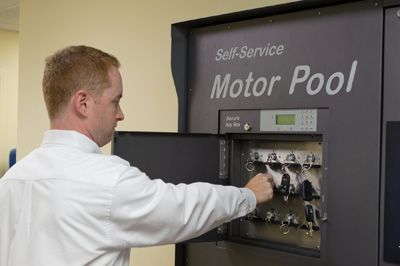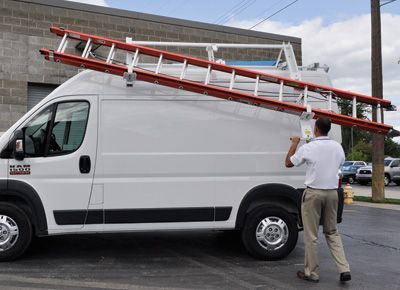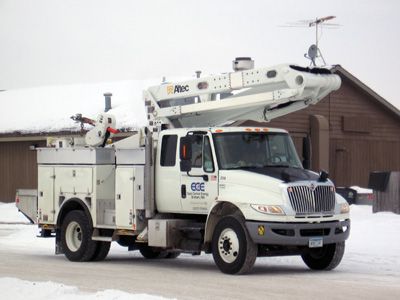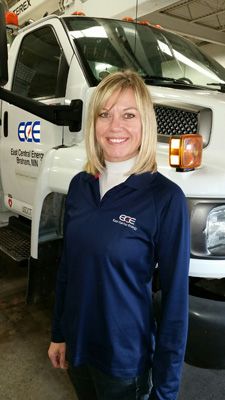About four years ago, East Central Energy, an electric distribution cooperative headquartered in Braham, Minn., underwent a corporate restructuring that shifted fleet from operations to the finance department. This reorganization, along with a drop in demand for new services, sparked an initiative to rightsize the fleet, said Holly Giffrow-Bos, East Central Energy’s fleet supervisor.
“When fleet was moved to finance, that’s when we started doing a lot more analyzing and measuring the financial performance of our fleet,” Giffrow-Bos said. “And when the scope of our business changed [with lower demand in new services], we analyzed the impact on our fleet. We measured and ranked our assets at each of our five locations, based on set criteria, to determine which assets we should keep, replace, reassign or eliminate.”
The result: about a 13 percent reduction in fleet assets, from 205 to 178 units since 2011, which has generated tens of thousands of dollars in annual savings for East Central Energy.
A reorganization of sorts also prompted a fleet rightsizing initiative for Matt Gilliland, fleet services manager at Nebraska Public Power District, which operates more than 1,100 fleet assets.
A few years ago, Gilliland’s fleet organization served only the transmission and distribution business units. But in 2012, his department’s responsibilities were expanded to oversee the fleets of all the district’s business units – a total of eight – creating opportunities for fleet consolidation and reduction.
“When we onboarded those business units, we rightsized their fleets, identifying about 70 assets that could go away,” Gilliland said.
Rightsizing Defined
Both Giffrow-Bos and Gilliland will tell you that rightsizing refers to more than simply downsizing. It’s about striking the optimal balance between fleet composition and business requirements. This is because, depending on changes in the business, rightsizing might actually mean having to add assets to maintain proper service levels to customers.
Rightsizing also relates to the right size or spec of a vehicle. In some applications, you might be able to downsize to a vehicle that offers a smaller, more fuel-efficient engine and lower purchase price. But in other instances, you might discover that you need to bump up to a larger truck because the current one has been consistently overloaded, creating premature maintenance issues and excessive downtime.
And it’s important to consider the right type of asset when formulating your rightsizing strategy. For example, you might have assigned someone an SUV, when a less expensive, more fuel-efficient passenger vehicle could still do the job. By making this switch, you may not be reducing the overall fleet size, but you are rightsizing both operational and capital expenditures.
Fleet Manager as Adviser
Any time there’s a proposed change – especially when it impacts a business unit’s access to equipment – there are politics involved. The fleet managers who know how to navigate those politics will be the most successful in implementing positive change for all affected parties.
This starts with the fleet manager taking on the role of an adviser to the leaders of each business unit, said Paul Lauria, who has conducted numerous rightsizing studies for government and utility fleets for more than three decades as president of Mercury Associates (www.mercury-assoc.com), a fleet management consulting firm based in Rockville, Md.
“In my view, the fleet manager’s role should be to help business units make sound fleet resource decisions that save money and do not impair the operators from doing their jobs,” Lauria said. “It’s not the fleet manager’s responsibility to force operators into accepting a particular type of vehicle. Instead, it’s their role to outline what are the most cost-effective types of resources to perform particular jobs.”
Gilliland agreed. “The role of the fleet manager is mostly tied to information,” he said. “It’s fleet’s job to identify what we should replace and when based on utilization history and life-cycle costing. We take that data and sit down with the supervisor of each independent business unit. We convey to them what we plan to replace and when, and they have an opportunity to provide good feedback on what they really need to do their jobs. It’s more of a collaborative process.”
Lauria said that business unit input is essential before making final decisions about whether to retire an underutilized asset. “That supervisor might say, ‘Yes, I have two backups. But that’s because we’re not doing a great job replacing our frontline units. So now I have to put those backups into service fairly often, while my frontline units are in the garage for repairs.’ Or it might be a situation where the supervisor says, ‘We’ve analyzed the demand for these types of assets during certain times of year and these assets are going to be heavily utilized in the winter months.’”
According to Giffrow-Bos, “If we see something underutilized, we get with the supervisor of that business unit and find out why they aren’t using it. Has the scope of the business changed? Or is it that we haven’t had any jobs that require this piece of equipment? If so, is this something you think you can live without? Or is this something you could rent when the need arises?”
Seeing the Big Picture
While business unit supervisors are best equipped to provide field-level insight into their equipment needs, the fleet manager sees the big picture.
“Fleet managers have enterprise-wide visibility into the costs of the fleet, and the deployment and utilization of vehicles,” Lauria said. “You wouldn’t expect individual business units to have that same visibility.”
And sometimes that difference in perspective can create tension between fleet and the business unit. “One of the key challenges when rightsizing is getting supervisors to see beyond their own business,” Gilliland said. “When it comes time to share or reassign vehicles, it’s somewhat difficult to get leadership of those units to see beyond themselves – to get one business unit to give up an asset for the benefit of another.”
So, how do you navigate a situation like this to help bring about consensus? “It comes down to communication and relationship building. You need to cultivate a relationship with that supervisor so you can have frank yet respectful conversations about what’s best for the organization as a whole,” Gilliland advised.
Lauria recommended using objective data to help business unit supervisors see the financial impact of keeping an underutilized vehicle. “A well-defined cost-chargeback system, for example, creates economic incentives for the business units to pay attention to the fixed cost of adding or keeping fleet assets,” he said. “If a business unit is charged $1,300 a month for the fixed cost of a piece of equipment they barely use, you’re empowering them to say, ‘You know what, this is crazy to keep this. We use this thing six hours a month and we need to explore other options for meeting this particular type of need.’ In some cases, there are no other good options, but the point is that a good charge-back system engages fleet users in the management of fleet costs.”
Rewards of Rightsizing
Even relatively small changes through rightsizing can yield considerable cost savings from a reduction in capital purchases and the elimination of ongoing maintenance, tax and insurance costs for each asset retired from the fleet.
For example, three years ago East Central Energy began the process of retiring or reassigning 12 vehicles by switching over to an IRS-approved driver reimbursement program managed by Runzheimer International (www.runzheimer.com), a Waterford, Wis.-based firm that provides mobility program management services. “We were able to take the 12 vehicles and reassign or eliminate them from the inventory,” Giffrow-Bos said. “If it was a decent truck and worthy to keep in our fleet, we would reassign it to another district and fulfill a need of another driver, without having to go outside and purchase a new one.”
The result? “We’ve saved about $38,000 annually with the 12 drivers on the program,” Giffrow-Bos said.
So, how often should you conduct a fleet rightsizing analysis for maximum benefit?
“If you’re talking about doing an enterprise-wide rightsizing study, I’d say once every five years,” Lauria advised. “If you’re identifying individual assets that are clearly being used less than the norm for that type of asset and application, then you could evaluate those opportunities for rightsizing at any time.”
An Ongoing Effort
The key takeaway here is that rightsizing is not a one-and-done project; it’s an ongoing, continuous improvement effort. That’s because the scope of your business can change at any time, directly impacting the number and type of assets you need to ensure that you’re maintaining a fleet that’s the right size.












